:quality(80)/business-review.eu/wp-content/uploads/2023/12/55b93b7c-0ee3-4d3a-86f1-e47d4a49db28.jpeg)
In the economic landscape of recent years, marked by increasingly high levels of government debt of the member states, but also by increased financing needs of public services, the reform of the current economic governance framework should ensure both the sustainability of public finances and the financing necessary for economic development, especially in the complicated times we are going through.
One of the main topics currently on the European agenda concerns the review of the current economic governance framework, with the Stability and Growth Pact as its central element. As a result of an extensive public consultation process, the European Commission published in November 2022 its guidelines for reforming the current economic governance framework, and in April 2023 it presented the new package of legislative proposals, addressing the shortcomings of the current rules, but also the lessons learned from the multiple crises that the member states have faced in recent years.
Also, at the end of November 2023, by presenting the autumn package for economic policy, which is based on the Autumn 2023 Economic Forecasts, the European Commission launched the European Semester 2024. Thus, the debates on the reform of the economic governance framework are going through a period of transition to the future set of legal rules that will establish the new fiscal-budgetary rules at the European level.
The reform mainly focuses on three legislative proposals, which mainly aim at:
• the preventive arm of the Stability and Growth Pact, aiming at the most effective coordination of economic policies and multilateral budgetary supervision,
• the corrective component of the Pact, by clarifying the excessive deficit procedure,
• the requirements regarding the budget frameworks of the member states.
The new fiscal-budgetary supervision framework thus aims to strengthen the sustainability of the public debts of the member states, but also to prepare them for the future challenges generated by the green and digital transition or the need to increase competitiveness at the European level. At the same time, the new proposals for revising the governance framework at the European level have in mind its simplification, a more pronounced orientation towards medium-term national plans that integrate structural reforms and far-reaching investments in key economic areas, but also a higher level of compliance with the rules by the member states, at the same time giving them a greater room for maneuver regarding the budgetary adjustment mechanisms.
The objectives of this reform of the economic governance framework are closely related to aspects such as the stability of public finances, the sustainability of government debts, the consolidation of economic growth, the avoidance and correction of existing macroeconomic imbalances and the prevention of the emergence of new ones, effective economic coordination, and the convergence of macroeconomic policies.
The cornerstone of the new reform proposals is the elaboration of medium-term structural budget plans at the national level, through which the member states will establish their main objectives in the fiscal-budgetary field, but also the measures through which they will propose to address, on a period of at least four years, priority reforms and investments, as well as the avoidance or, as the case may be, the correction of possible macroeconomic imbalances.
Simplifying and circumstantializing the current rules according to the specifics of each member state is another aim of this reform, taking into account the lessons learned from the recent crises and also taking into account the fact that experience has shown that a general approach cannot consider the challenges and the economic situation of each country, which can vary significantly across the 27 EU member states.
The new legislative package also aims to facilitate large-scale investments and structural reforms, especially in the areas considered to be a priority at the European level, by establishing transparent criteria and potential gradual fiscal adjustment mechanisms that would benefit the member states that commit to such reforms and strategic investments through their national plans.
Also, the efficiency of the application of the governance rules and the mechanisms for monitoring compliance with the commitments that the member states assume through the medium-term fiscal-budgetary plans is considered.
Debates on the reform of European economic governance take place in various forums, for example within the ECOFIN Council, within the Economic and Financial Committee or within the Eurogroup for issues that particularly concern the euro area, and cover a number of aspects such as:
• maintaining the reference values of 3% of GDP for the budget deficit and, respectively, of 60% of GDP for the public debt;
• a potential differentiated application of the budget rules by the member states, depending on the challenges they face from the perspective of public debts (based on an analysis of the European Commission on the sustainability of public debts);
• medium- and long-term reorientation, by establishing, on the one hand, a commitment by the member states to comply with medium-term fiscal-budgetary structural plans, and on the other hand, by carefully monitoring these plans;
• the implementation of effective mechanisms regarding the implementation of the new rules;
• revising the system of sanctions (financial, reputational, etc.), strengthening the role of reforms and investments (especially those related to the double ecological and digital transition) and, last but not least, maintaining the excessive deficit procedure and the rules for enabling/disabling it.
Given the level of complexity and the implications of the key issues that are the subject to the review process of the European Union’s governance framework, partly mentioned above, and taking into account the specificities and challenges faced by each of the member states, there are of course, within the debates certain common opinions, but also divergent or problematic aspects that still require additional decisions or clarifications, both on the level of principal and in terms of implementation and implementation methods.
Romania is subject to the excessive deficit procedure, from April 2020, as a result of exceeding the threshold of 3% of GDP provided in the Stability and Growth Pact. According to current regulations at European level, the correction of the excessive deficit must take into account the economic and budgetary position of the state concerned and should normally be completed in the year following its identification, unless there are special circumstances. In Romania, there were such special circumstances at the time, in the context of a very high level of uncertainty associated with the Covid-19 pandemic.
Moreover, given the exceptional economic and budgetary situation generated by the pandemic, the European Commission considered that the conditions for activating the general derogatory clause in the Stability and Growth Pact are met. On March 20, 2020, the EU Council, at the proposal of the Commission, thus activated the general derogatory clause, allowing the member states some deviations from the obligations assumed to reach the medium-term targets and thus creating the premises for the adoption of urgent measures with significant budgetary consequences. At the same time, in order to offer the member states the necessary flexibility to mitigate the shocks generated mainly by the Covid-19 pandemic and the war in Ukraine, the period of application of the derogatory clause was subsequently extended, eventually including also the year 2023.
From the perspective of the preventive arm of the Pact, the activation and subsequent extension of the derogation clause allowed member states to temporarily deviate from their adjustment trajectories towards the medium-term budgetary objectives, provided that it did not jeopardize their fiscal sustainability. If a member state is subject to the corrective arm of the Pact (the case of Romania) as a result of the activation of the derogatory clause, the EU Council can decide, on the recommendation of the Commission, to propose a review of its fiscal trajectory.
In this context, the EU Council addressed a recommendation to Romania according to which the excessive deficit situation should be corrected by 2024 at the latest. Romania must therefore make significant efforts to consolidate the budget, which would ensure the correction of the excessive budget deficit in a sustainable manner, involving a series of economic and budgetary reforms.
The general derogatory clause from the provisions of the Stability and Growth Pact would cease to apply at the end of the current year, and the Commission expressed its intention to propose to the EU Council, in the context of the European Semester, the opening, in the spring of 2024, of the procedures for excessive deficit, based on data from the financial year 2023, for member states which do not meet the 3% target. According to the Autumn 2023 Economic Forecasts of the European Commission, in addition to Romania, it is possible that from next year other member states, for example France, Italy, Spain, Poland, the Czech Republic, Slovakia, Hungary, be subject to this procedure.
Also, for 11 member states (including Romania, but also France, Germany, Greece, Cyprus, Italy, Hungary, the Netherlands, Spain, Portugal, and Sweden) facing economic imbalances in 2023 according to the Alert Mechanism Report, in 2024 there will be in-depth analyses to show whether the respective imbalances are corrected or, on the contrary, accentuated, in order to establish possible fiscal policy guidelines. In the case of Romania, the Commission considers necessary, in 2024, an in-depth analysis regarding the persistence of macroeconomic imbalances, with an emphasis on aspects such as the level of the budget deficit, the sustainability of the public debt, the competitiveness of costs, etc.
Between 2021-2022, Romania’s budget deficit decreased compared to the level of 2020, but compliance with the assumed targets still represents a major challenge for our country.
According to data published by Eurostat, the level of the government deficit recorded in the EU member states (calculated according to the ESA 2010 methodology) decreased in 2022 compared to 2021, from 4.7% of GDP to 3.3% of GDP.
However, as can be seen from Figure 1 below, the majority of member states (22 states out of the total of 27) recorded a budget deficit for the year 2022. Of the 22 member states, more than half (12 states, including Romania) had in 2022 a budget deficit level above the limit of 3% of GDP.
At the same time, from the graph below it can be seen that Romania is, unfortunately, among the EU member states with the highest levels of budget deficits in the reference period.
Regarding the year 2023 and the following years, according to the latest forecast of the European Commission (Autumn 2023 Economic Forecasts), the level of the budget deficit recorded in the member states of the European Union will continue to decrease to 3.2% of GDP (2023), 2.8% of GDP (2024), and to 2.7% of GDP (2025), respectively.
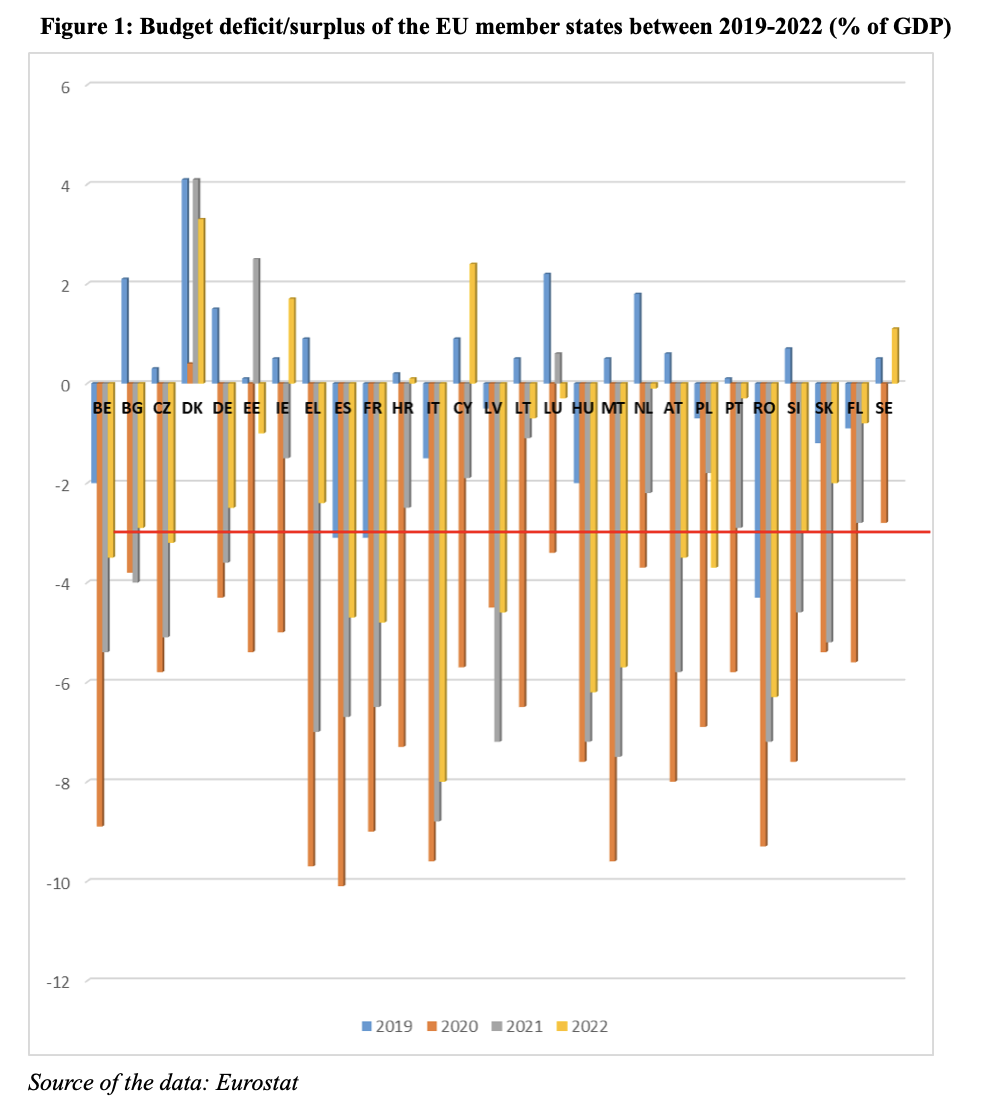
However, as can be seen from the graph below, in 2023, but also in 2024, 12 member states will have, in accordance with the European Commission’s Autumn 2023 Economic Forecasts, a budget deficit level above the limit of 3% of GDP, and their number will increase to 13 in 2025.
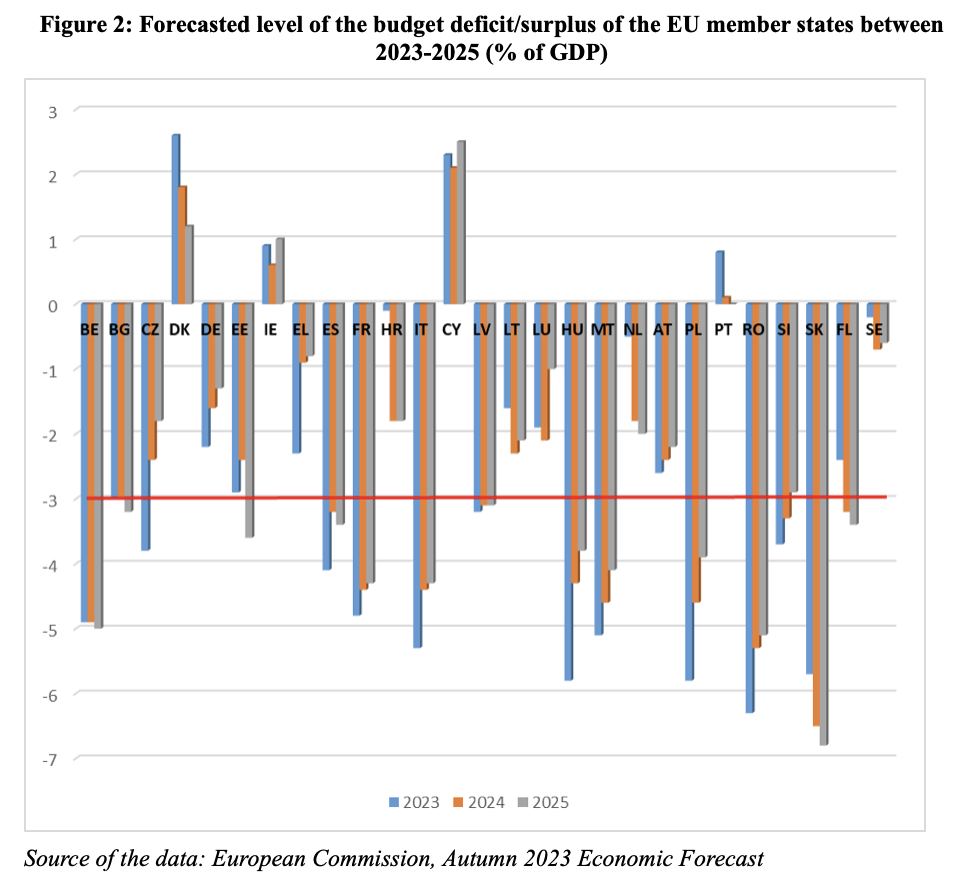
For Romania, the European Commission estimates, in the context of the Autumn 2023 Economic Forecast, a level of the budget deficit of 6.3% of GDP for 2023 (similar to the one for 2022, i.e. a considerable upward revision compared to the level of 4.7% of GDP provided in the spring forecast), with it subsequently decreasing to 5.3% of GDP in 2024, respectively to 5.1% of GDP in 2025, as a result of the package of fiscal measures applicable from January 1, 2024.
In Romania, the revenues collected at the state budget are among the lowest compared to those of other member states of the European Union, their level being at the same time far below the European average, generating considerable pressure on economic balances over time.
According to Eurostat data, at the European Union level, budget revenues (from taxes and social contributions) represented 41.2% of GDP in 2022, down from 2021 (41.5%). Romania, with a level of budget revenues from taxes and social contributions of only 27.2% of GDP in 2021, respectively 27.5% of GDP in 2022, was in penultimate place at the level of the European Union. Other member states that recorded in 2022 a level of budgetary revenues from taxes and social contributions as a percentage of GDP below the EU average were Malta (29.6 %), Latvia (30.8%), Bulgaria (31.1 %), Hungary (35.1 %), Poland (35.3 %), or the Czech Republic (35.4 %). On the other hand, the highest levels of budget revenues from taxes and social contributions as a percentage of GDP in 2022 were recorded in France (48%), Belgium (45.6%), Austria (43.6%), Finland and Greece (each with 43.1 %), and Italy (42.9 %).
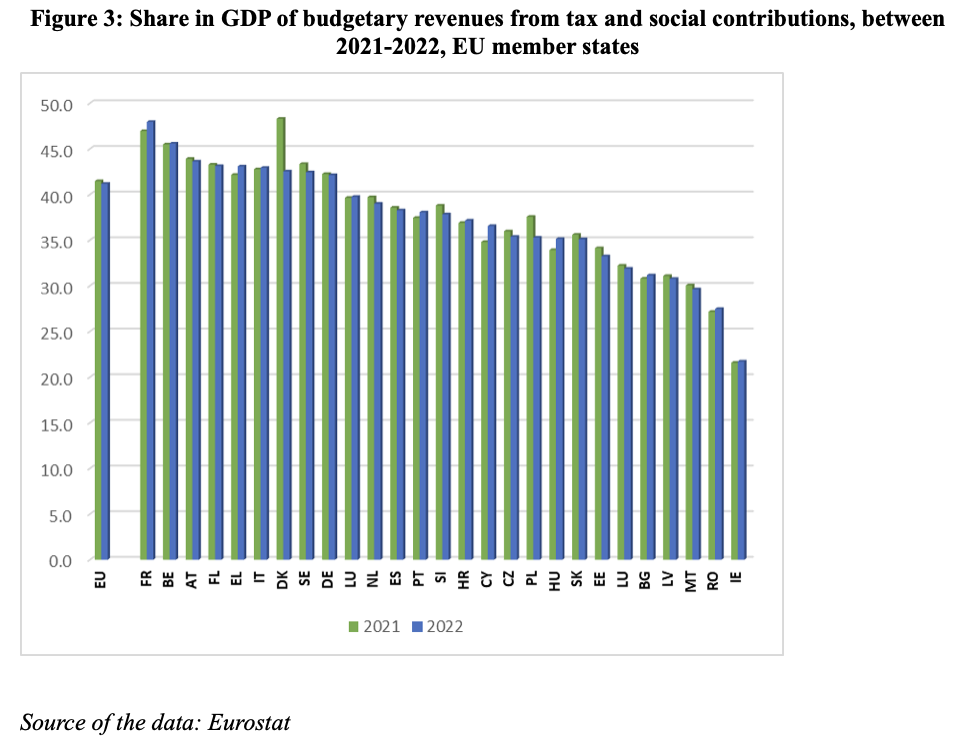
As for the level of government debt, it is below 60% of GDP in many member states, but also well over 100% of GDP in others which represent a significant part of the GDP of the euro area.
In 2022, according to Eurostat, a decrease in the level of the public debt of the member states can also be observed, compared to the year 2021. Thus, with reference to the euro zone, the level of government debt, according to the EU methodology, decreased from 94.8% of GDP (2021) to 91% of GDP (2022), and at EU level as a whole, the level of government debt also decreased to 83.5% of GDP (2022) from 87.4 % of GDP (2021).
At the end of 2022, the lowest share of government public debt in GDP was recorded in states such as Estonia (18.5%), Bulgaria (22.6%), Luxembourg (24.7%), Denmark (29.8%), Sweden (32.93%), or Lithuania (38.1%). On the other hand, 13 member states recorded at the end of 2022 a share of government public debt in GDP above the 60% ceiling, the highest levels being reported by countries such as Greece (172.6%), Italy (141.7 %), Portugal (112.4%), France (111.8%), Spain (111.6%), or Belgium (104.3%). In order to have a clearer picture of the developments in recent years, we present below a comparative situation regarding the level of government debt (% of GDP) for the period 2019-2022 at the level of EU member states.
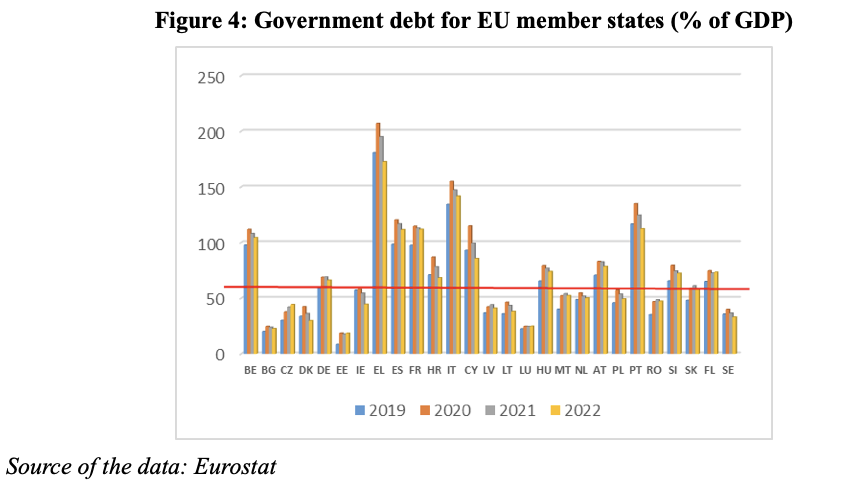
In Romania, the share of government debt in GDP increased considerably between 2007-2017, after the start of the global financial crisis, reaching in recent years almost 50% of GDP, thus remaining below the 60% ceiling established by the Maastricht Treaty.
According to the European Commission’s Autumn 2023 Economic Forecast, Romania’s public debt is expected to increase in the coming years, reaching 50.5% of GDP in 2025, amid still large deficits and slower nominal GDP growth in the following years.
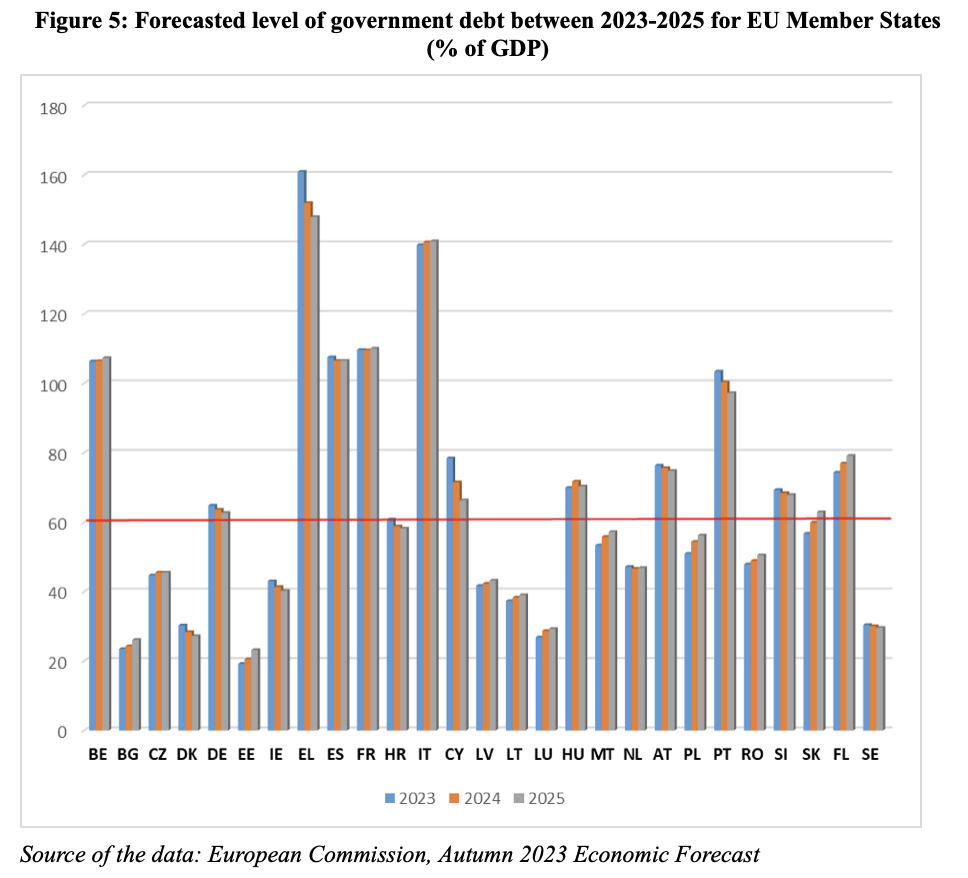
Discussions on amending the Stability and Growth Pact highlight an important moment for member states. Moreover, they must also take into account the risks generated by the current global context, marked mainly by the continuation of Russia’s war against Ukraine and the re-intensification of the conflict in the Middle East to very high levels, as well as by the general changing geopolitical situation, which can negatively influence international trade and make external conditions difficult. In such a context, it is important to re-examine how Member States’fiscal and structural policies could contribute to rebalancing the policy mix and the role that the EU’s economic governance framework could play in this regard.
At present, the need for fiscal policies to contribute to macro-financial stability and support monetary policy in reducing inflation, while supporting economic growth and providing sufficient fiscal space for strategic investments, especially in key economic areas, will be reaffirmed.
These changes, meant to offer more flexibility but to preserve the rigor and consolidation trajectory of the fiscal policies of the EU states, could significantly influence the economic evolution of Romania, which is still in full development process. It is essential to continue the process of gradual fiscal consolidation, which allows reaching the targets for exiting the excessive deficit procedure, which requires rigor, but also flexibility, discipline, but also credibility, coherence and, above all, counter-cyclicality.
On the other hand, Romania faces two exceptional opportunities, which can contribute to mitigate the impact of the macroeconomic corrections that are required in such a context and to the implementation of much needed structural reforms, namely, attracting the funds allocated through the National Plan for Recovery and Resilience and the OECD accession process. Therefore, the calibration of the set of objectives of the economic policy mix must ensure a balance between ambitions and realism, between budgetary prudence and the stimulation of economic growth, between the need to reduce the deficit and the public debt and the need to encourage structural reforms and strategic investments.
The potential relaxation of fiscal constraints to account for public investment programs means that Romania could maintain the necessary allocations for infrastructure, health and education, even though it is in the process of consolidating public finances. It is important that, in the medium term, this increased fiscal freedom is administered in such a way as to ensure a sustainable trajectory of the level of public debt in GDP, therefore without jeopardizing future economic stability.
Likewise, the reform of the Stability and Growth Pact will require a careful recalibration of Romania’s fiscal policy. The government will have to find a balance between using the investment advantage conferred by possible slightly more relaxed fiscal rules, adapted to the specifics of the Romanian economy, and maintaining spending discipline to avoid excessive budget deficits and unsustainable levels of government debt. This would entail perpetuating a robust framework for fiscal planning and execution, with particular emphasis on efficiency, transparency, accountability, fairness, and equal treatment in terms of taxation, revenue collection, and public expenditure. Possible more nuanced fiscal rules, adapted to the specific economic conditions of each member state, imply the development of an increased capacity within the public administration to adapt to these new rules, to effectively plan budgets and to respond to economic fluctuations.
As Romania’s public finances will fold on these expected changes to the European framework in the field, it will be important to closely monitor the economy’s response to the new shape of the economic policy mix. The flexibility offered by the revised Pact could be a double-edged sword, offering opportunities for growth but also presenting risks if not managed carefully. Collaboration between the public administration and the private economic environment will probably become imperative, in order to ensure the alignment of fiscal policies with national priorities and economic development opportunities identified by the private environment, as well as with the broader objectives of the European Union. In the long term, these changes have the potential to create opportunities for Romania to strengthen its economic position within the Union, provided they are approached with seriousness and caution. The starting premise is a favourable one, the ultimate goal of these reforms being to facilitate sustainable economic development and increase the well-being of citizens throughout the European Union. It depends on each state how it succeeds in taking advantage of the opportunities that lie ahead in the medium and long term.



:quality(80)/business-review.eu/wp-content/uploads/2015/08/key-interest-BNR.jpg)



:quality(80)/business-review.eu/wp-content/uploads/2024/06/22C0420_006.jpg)

:quality(80)/business-review.eu/wp-content/uploads/2024/06/COVER-1-4.jpg)



:quality(50)/business-review.eu/wp-content/uploads/2023/04/Leonardo-Badea-BNR.jpg)
:quality(50)/business-review.eu/wp-content/uploads/2023/09/Leonardo-Badea-BNR.jpg)
:quality(50)/business-review.eu/wp-content/uploads/2015/09/inflation.jpg)
:quality(80)/business-review.eu/wp-content/uploads/2024/06/br-june-2.jpg)
:quality(50)/business-review.eu/wp-content/uploads/2024/07/VGP-Park-Timisoara_-8thbuilding_iulie-24.jpg)
:quality(50)/business-review.eu/wp-content/uploads/2024/07/America-House-Offices-Bucharest-Fortim-Trusted-Advisors.jpg)
:quality(50)/business-review.eu/wp-content/uploads/2024/07/BeFunky-collage-33-scaled.jpg)